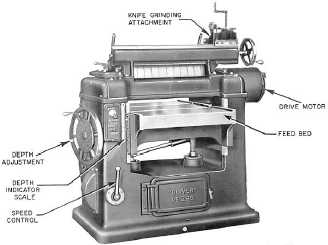back, your hands will drop on the blades. Start with your hands on the infeed bed. When the piece of wood is halfway through, reach around with your left hand and steady the piece of wood on the outfeed bed. Finish with both your hands on the outfeed bed.
Never feed a piece of wood with your thumb or finger against the end of the piece of wood being fed into the jointer. Keep your hands on top of the wood at all times.
Avoid jointing short pieces of wood whenever possible. Joint a longer piece of wood and then cut it to the desired size. If you must joint a piece of wood shorter than 18 inches, use a push stick to feed it through the jointer.
Never use a jointer with dull cutter blades. Dull blades have a tendency to kick the piece, and a kickback is always dangerous.
Keep the jointer table and the floor around the jointer clear of scraps, chips, and shavings. Always stop the jointer before brushing off and cleaning up those scraps, chips, and shavings.
Never joint a piece of wood that contains loose knots.
Keep your eyes and undivided attention on the jointer as you are working. Do not talk to anyone while operating the jointer.
Remember, the jointer is one of the most dangerous machines in the woodworking shop. Only experienced and responsible personnel should be allowed to operate it using the basic safety precautions provided above.
Surfacer
A single surfacer (also called a single planer) is shown in figure 3-11. This machine surfaces stock on one face (the upper face) only. (Double surfacers, which surface both faces at the same time, are used only in large planing mills.)
The single surfacer cuts with a cutterhead like the one on the jointer, but, on the single surfacer, the cutterhead is located above instead of below the drive rollers. The part adjacent to the cutterhead is pressed down against the feed bed by the chip breakers (just ahead of the cutterhead) and the pressure bar (just behind the cutterhead). The pressure bar temporarily

Figure 3-11. - Single surfacer.
Continue Reading